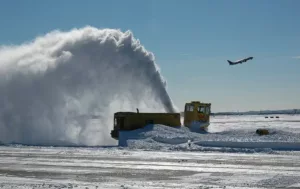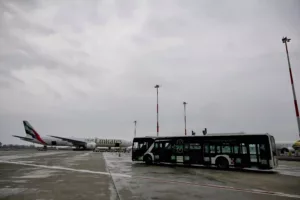Airport operators in colder climates are faced with a unique challenge, as the road to decarbonization around the world rapidly picks up speed: can electric airport buses operate in the cold? Are there reliable models that can handle below-freezing temperatures? This is an understandable worry for areas where temperatures frequently fall below -20°C, or even as low as -40°C. When choosing ground support vehicles for these locations, it’s a crucial consideration that isn’t to be skipped.
This problem is addressed head-on by DINOBUS vehicles. These buses are not only durable, but they are also tailored for various winter conditions, with the ability to perform without a hitch in climates as low as -40°C. DINOBUS provides a strong, clean-energy option for airports in Northern Europe, Central Asia, and North America without sacrificing vehicle dependability or the comfort of the traveler.
The systems and parts used in DINOBUS buses are made to officially function safely in temperatures as low as -40°C. This includes its HVAC systems, pre-heating features, cold-weather battery management, and reinforced insulation. When riding one of these buses through the terminal, a comfortable journey is our guarantee.

Engineered for Extreme Cold: Down to -40°C
A modernized battery thermal control system, which maintains batteries at the ideal temperature for charging and discharging even during deep freezes, is at the heart of strong electric vehicle performance. Battery-powered vehicles are known to be vulnerable during colder weather, which results in the destabilization of their efficiency during performance. In order to maintain dependable range and power, however, DINOBUS uses active battery maintenance and systems to maintain heat.
Cabin interiors are made to withstand severe winters as well. Comfort is guaranteed even in the event of freezing temperatures, thanks to the passenger areas’ robust electric heating and effective temperature control.
Which Countries Can Benefit?
An electric apron bus’s cold-weather capability makes it an ideal clean alternative for a wide variety of countries and regions. Scandinavia is a great candidate. Airports located in Norway, Finland, and Sweden frequently operate in temperatures of -30°C and below. Additionally, the Baltic states have already proven to be active EV adaptors. This is because Baltic nations like Lithuania and Estonia annually face snowy winters with high de-icing demands. Eastern Europe, especially countries like Poland, are just as likely to benefit. Airports in Warsaw, Kraków, or Riga require year-round vehicle resilience when it comes to passenger handling. In these airport locations, ground support equipment needs to have the ability to operate reliably in the snow, ice, and strong winds.
Why DinoBuses Are a Smart Choice in Cold Climates
While the idea of operating electric vehicles in harsh winter conditions might seem unreliable, contemporary electric passenger buses are actually able to secure several advantages over diesel fuel alternatives in the cold.
No Engine Warm-Up Needed
Electric buses don’t need to leave the engine idling or have a dedicated warm-up time when turned on. They can start fast, reliably, and without the need for using block heaters or fuel additives.
Less Maintenance in Harsh Conditions
Winter weather can be especially hard on diesel engines and parts. Electric powertrains have far fewer components in their design, meaning less maintenance needed, fewer breakdowns, and maximized uptime during inconvenient snowstorms.
Optimized Energy Use
During the more slippery conditions, regenerative braking can effectively increase energy efficiency, and it also enhances the driver’s control and reduces brake wear. Both are a major plus during icy days.
Zero Emissions
During the colder months, air pollution from onsite diesel engines can often be found lingering around the ground level. Electric buses greatly reduce this phenomenon, improving the health and working conditions for staff and travelers alike.
Renewable Energy Integration
Northern countries often have strong hydro or wind power infrastructure. Airports can align EV charging with clean local electricity, further cutting CO₂ emissions.

Cold Is No Longer a Barrier to Electrification
Airports in cold climate regions no longer have to choose between strong dependability and sustainability, all thanks to modern bus technology. Built from the ground up in order to succeed in winter operations, these electric apron buses reduce emissions while using less fuel and requiring less maintenance.
DINOBUS is ready to demonstrate that electric buses aren’t limited to mild climates; they can be operated anywhere. Major international airports from Helsinki to Montreal are already upgrading their ground fleets to battery power. Airports can rely on DINOBUS as a partner when it comes to climate consciousness, performance, and durability at freezing temperatures.